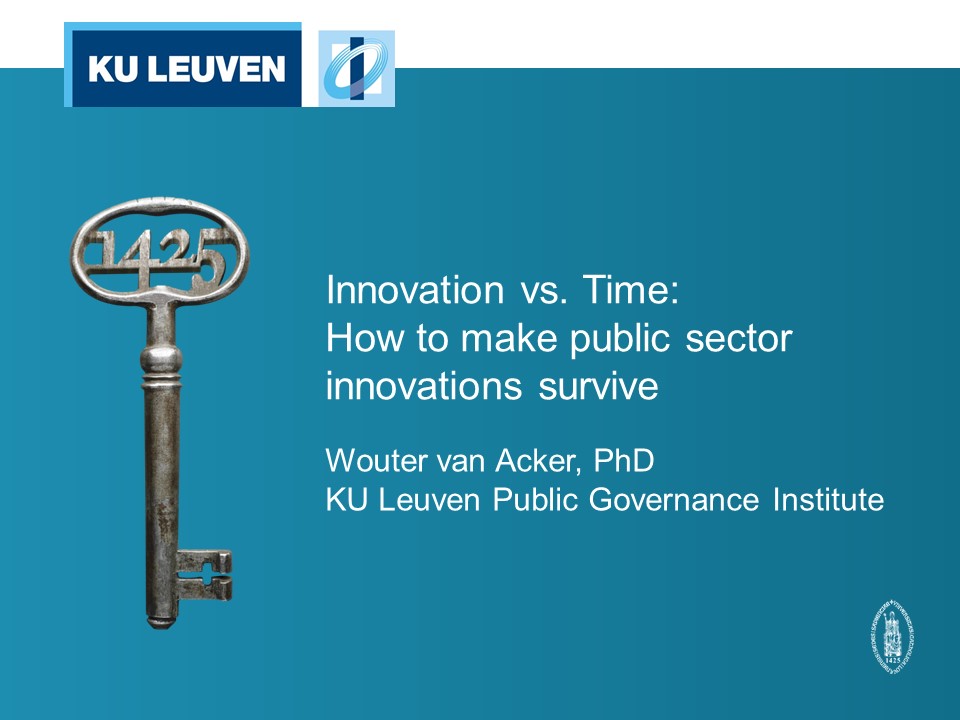Innovation vs. Time: How to make public sector innovations survive

This blog was guest written by Wouter van Acker, PhD, KU Leuven Public Governance Institute
I should know better than to write a blog starting with a ‘how-to-title’. One conclusion after writing a PhD on public sector innovation, which is what I did and why I’m writing here, is that there is no such thing as a ten-tip-recipe-for-success in innovation. But we all succumb to the appeals of clickbait. So here we are.

In 2014 I started my quest into finding out what could make innovations in the public sector sustainable. We know quite a few things about what happens before an innovation is implemented (why some organizations are more innovative than others, what the innovation process looks like, what innovation diffusion looks like), but what happens after that point of implementation remains a black hole. That is: for us academics. How many of these innovations survive? How long do they last? Why do some terminate, and others not? Besides us at the KU Leuven Public Governance Institute, research teams in France, the Netherlands, Romania, Slovakia and the UK carried out 220 surveys, dozens of interviews, and came to a conclusion. What makes innovations survive, is first and foremost a specific culture. One that’s open to critical debate, experimentation, failure, and transparency.
Where did we start: with the idea that continuous improvement, agility and adaptation of the innovations, might increase their chances of survival in the long run. We came up with a model of three factors: feedback, accountability, and learning. When organizations with a newly introduced innovation:
- gather feedback information on the innovation’s efficiency and effectiveness
- are kept on their toes through accountability mechanisms (audit offices for example)
- and can transform this pressure and feedback information through learning
We expected their innovations to stand a better chance against the test of time. With these three factors in place, an organization would be able to adapt the innovation when needed. By constantly checking if the innovation was addressing the needs of its users, as efficiently as possible, innovations can be continuously improved.
Luckily for me, the results turned out to be in agreement. Or at least sort-of.
In the survey results we found that feedback, accountability and learning came to the fore in two different ways: as a culture, and as instruments. As a culture it predicted greater sustainability, and greater survival chances, if it included:
- Productive and adversarial debate
- Being able to discuss ideas and problems
- Staff members who feel responsible for performance
- Room for failure and experimentation
- Staff members who care about transparency.
As instruments, it was about having:
- Monitoring systems to measure performance
- An internal audit office
- A quality management system
- Formal procedures for the diffusion of lessons learned.
Interestingly, the instrument of feedback, accountability, were not found to influence the survival chances of the innovations. Even though you would think that they form the basis on which a culture of feedback, accountability and learning can function, instruments were insufficient to explain innovations’ termination. This turned out later, through the interviews for three case studies where the innovations had been terminated.
A lack of feedback culture seemed necessary in all three of these cases. The existence of instruments alone was insufficient to keep the innovation alive. Additionally, two other factors were found to be necessary for keeping innovations sustainable: the well-known issue of innovation champions, and a consensus on the appropriateness of the innovation. First off, the champions (the leaders, supporters and often originators of the innovations) are necessary to keep the spirit of the innovation alive. Furthermore, they often store a large majority of the knowledge about the innovation in them. Where they leave the organization, the innovation loses its prime supporter, and a significant part of its knowledge base. Secondly, there needs to be agreement among the key players that the innovation is the right thing to do. If the innovation is not seen as an appropriate solution to the problem, its efficiency and effectiveness have little say in whether or not it is seen as good, and whether or not it survives.
So, in short, my advice to practitioners is: If you want to create innovations that last, pay attention to what happens after the innovation is implemented. A great design is not enough to make the innovation sustainable. Try creating an open culture of feedback, accountability and learning. One with room for debate, experimentation and failure. One with transparency and responsibility as prime values among staff members. One where there is consensus on the idea behind the innovation, on its appropriateness. And finally, one where the champion of the innovation either stays around, or where her knowledge about and support for the innovation is properly carried on. With those issues in place, your innovation would stand a better chance of survival.
If you like what you read, there’s this article with more information. There’s even the dissertation itself, if you have the stomach for it. For any questions, or a copy of my dissertation, I’m always available at wouter.vanacker[@]kuleuven.be, and @woutervanacker.












